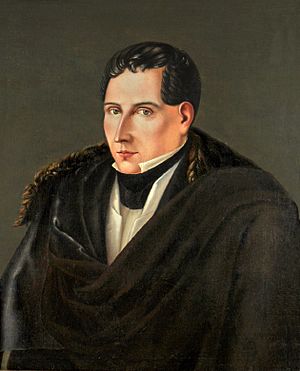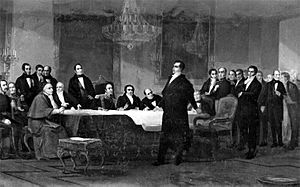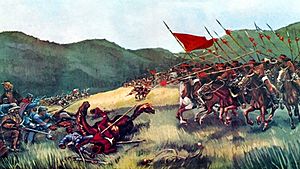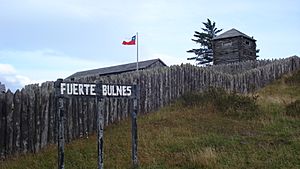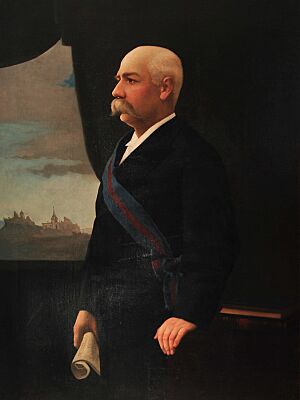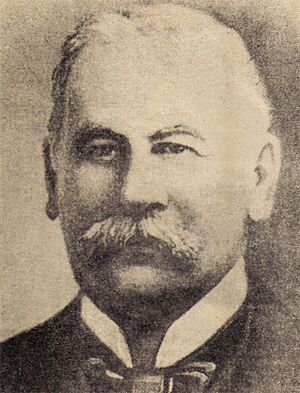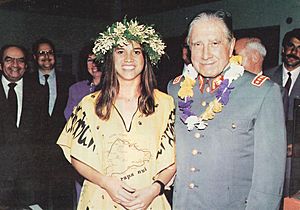Chilean expansionism facts for kids
Chilean expansionism refers to Chile's plan to grow its territory and control important places and resources. This was done to keep the country safe and strong in South America. Most of Chile's big land gains happened in the 1800s. These changes helped Chile become a powerful country with a strong navy (a Thalassocracy) and one of the three richest nations in South America during the 1900s. It also shaped Chile's identity as a country that stretches across three continents and has one of the longest coastlines in the world.
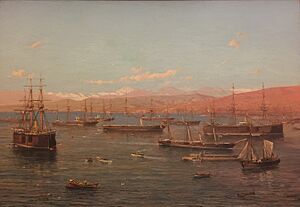
After Chile became independent from Spain in 1818, its land was roughly the same as the old Spanish colony called the General Captaincy of Chile. A rule called uti possidetis iuris helped set the borders for the new South American countries. Under this rule, Chile bordered Bolivia to the north in the Atacama Desert and Argentina to the east.
To the south, Chile claimed all the land west of the Andes Mountains and all of Patagonia, especially for the Strait of Magellan. But in reality, Chile only controlled the area down to the Bío Bío River and the land between Valdivia and the Chiloé Archipelago. The rest of the southern land was controlled by the independent Mapuche people in Araucanía or had very few people from other native tribes.
However, the uti possidetis system didn't last long. Without clear border agreements, many land disputes started across the continent. This uncertainty created both problems and chances for Chile. While diplomatic situations were tricky, it also allowed Chile to grow its power. Chilean leaders wanted to make sure the country's borders and the regional balance of power helped their economic and political goals. To do this, Chile made its military stronger, especially its navy, to use a policy of showing force.
To its north, Chile became dominant by stopping the union of Bolivia and Peru during the War of the Confederation (1836-1839). Later, Chile took over the mineral-rich lands of these countries in the Atacama during the War of the Pacific (1879-1884). This left Bolivia without access to the sea and led to Chile taking over the Peruvian capital.
To its south and east, Chile used military force and encouraged people to settle new lands to take over Araucanía (1861-1883). Chile also successfully argued against Argentina's claims over western Patagonia and the Strait of Magellan, avoiding war many times. Chile's expansion mostly ended with the taking of Easter Island in 1888. But some parts of this expansion continued into the 1900s, like Chile's claim over Antarctic land in 1940.
Even though Chile didn't get all the land it wanted, its success caught the attention of the United States, another country that was expanding. This also made Chile a strong regional power in Latin America. Chile's growth also created distrust with its neighbors, who still have border disagreements with Chile. The way Chile treated the people in its new lands, especially the government's efforts to make them adopt Chilean culture (called "Chilenization"), led to problems inside the country. This caused the Mapuche and Rapa Nui people to ask for more control over their own areas, or even independence.
Contents
Why Did Chile Expand?
After gaining independence, the new Republic of Chile inherited land from the old Spanish colony. But its borders were not clearly defined. Its northernmost town was Copiapó in the southern Atacama Desert, bordering Bolivia. However, the exact border was argued about until 1866. That year, both countries agreed on a border at the 24° South parallel from the Pacific Ocean.
Its southernmost town was Concepción. This was a few kilometers north of the border between Chile and Araucanía. Araucanía was the land that the Mapuche native people had successfully kept after defeating Spain in the Arauco War.
A key Chilean leader, Diego Portales, believed Chile should always be strong in the Pacific Ocean. He wrote in a letter in 1836, "We must always dominate in the Pacific: This must be its [Chile's] maxim now, and hopefully will be Chile's forever." This idea guided Chile's actions.
How Chile Expanded Its Territory
Taking Over the Atacama Desert
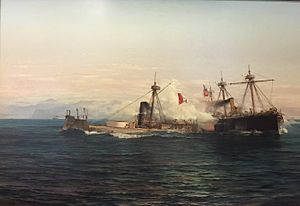
To its north, Chile showed its strength by ending the union of Bolivia and Peru during the War of the Confederation (1836-1839). Later, Chile took over the mineral-rich lands in the Atacama Desert from these countries during the War of the Pacific (1879-1884). This war left Bolivia without access to the sea and led to Chile taking over the Peruvian capital.
Chile slowly began to grow its influence and set its borders. The Chiloé Archipelago became part of Chile in 1826. The economy started to grow quickly because silver was found in Chañarcillo. Also, the port of Valparaíso became very busy with trade. This led to disagreements with Peru over who controlled the sea in the Pacific.
The Boundary treaty of 1881 between Chile and Argentina confirmed that Chile owned the Strait of Magellan. Because of the War of the Pacific with Peru and Bolivia (1879–83), Chile's territory grew by almost one-third to the north. Bolivia lost its access to the Pacific Ocean. Chile also gained valuable nitrate deposits. Mining these nitrates brought a time of great wealth to Chile. By 1870, Chile was one of the high-income countries in South America.
Taking Over Araucanía
To its south and east, Chile used military force and encouraged people to settle new lands to take over Araucanía (1861-1883). Chile also successfully argued against Argentina's claims over western Patagonia and the Strait of Magellan. War was almost started many times.
Settling Patagonia
At the same time, Chile tried to strengthen its control in southern Chile. It increased its efforts to move into Araucanía and brought German immigrants to settle Llanquihue in 1848. The Magallanes Region became part of Chile in 1843 when Fort Bulnes was founded by the Schooner Ancud under the command of John Williams Wilson. Meanwhile, the Antofagasta area, which was part of Bolivia at the time, started to attract many people.
Annexing Easter Island
Chile's interest in expanding into the Pacific Ocean islands began during the time of President José Joaquín Prieto (1831-1841). Diego Portales believed that Chile's expansion into Polynesia was a natural step for a country with a strong navy. The first part of Chile's expansion into the Pacific started ten years later, in 1851. After an American ship entered the Juan Fernández Islands, Chile's government officially made the islands a part of Valparaíso.
In the same year, Chile's merchant ships successfully created a market for farm goods. This market connected the Californian port of San Francisco with Australia. This made Chile even more interested in the Pacific. By 1861, Chile had a successful trading business across the Pacific. Its money, the Chilean peso, was used widely in Polynesia. Chilean merchants traded in the markets of Tahiti, New Zealand, Tasmania, and Shanghai. There were also talks with the Spanish Philippines, and reports of disagreements between Chilean and American whaling ships in the Sea of Japan. This period ended when Spanish forces destroyed Chile's merchant fleet in 1866 during the Chincha Islands War.
Chile's dreams of expanding into Polynesia came back after its big victory against Peru in the War of the Pacific. This war made the Chilean fleet the strongest naval force on the Pacific coast of the Americas. Valparaíso also became the most important port on the Pacific coast of South America. This allowed Chilean merchants to find markets in the Pacific for the new mineral wealth from the Atacama.
During this time, Chilean writer and politician Benjamín Vicuña Mackenna (who was a senator from 1876 to 1885) strongly supported Chile's expansion into the Pacific. He believed that Britain had taken Spain's discoveries in the Pacific. He imagined that Chile's duty was to create an empire in the Pacific that would reach Asian shores.
In this time of strong desire for expansion in 1886, Captain Policarpo Toro of the Chilean Navy suggested to his leaders that Chile should annex Easter Island. President José Manuel Balmaceda supported this idea because the island seemed to have a good strategic location and economic value. After Toro transferred the rights to the island's sheep farming from businesses in Tahiti to the Chilean-based Williamson-Balfour Company in 1887, Easter Island officially became part of Chile. This happened when the "Agreement of Wills" was signed between Rapa Nui chiefs and Toro, on behalf of the Chilean government, in 1888.
Claiming Antarctic Territory
Chile also made a claim over a part of Antarctica in 1940, continuing its expansionist ideas into the 20th century.
What Happened Because of Chile's Expansion?
In 1978, during talks to solve the Beagle conflict, Chilean leader Augusto Pinochet said that Chile had no plans to expand. But he also said his government would "defend the land that belongs to it by right."
In the late 1800s and early 1900s, Chile temporarily solved its border disputes with Argentina. This happened with the Puna de Atacama Lawsuit of 1899 and the Cordillera of the Andes Boundary Case in 1902.
Chile becoming a major power in the South Pacific also meant it came into direct conflict with the United States.
Criticisms of Chile's Expansion
Some people, like Chilean diplomat Juan Salazar Sparks, argue that the ideas of Andrés Bello and Diego Portales were not about expanding territory or interfering in other countries. Instead, he believes they thought Chile's role as a strong naval nation and a supporter of unity in the Americas was based on its moral leadership, cultural influence, and keeping the regional balance of power. He also thinks Chile was forced into wars with Peru and Bolivia to protect this balance. He sees Chile's involvement in the Chincha Islands War as proof of its commitment to Pan-Americanism.
Another Chilean researcher, Felipe Sanfuentes, also argues that Chile was not an expansionist country. He believes this idea is often promoted by Argentina's desire to reclaim Tierra del Fuego and Patagonia.
|
See also
 In Spanish: Expansión territorial de Chile para niños
In Spanish: Expansión territorial de Chile para niños


